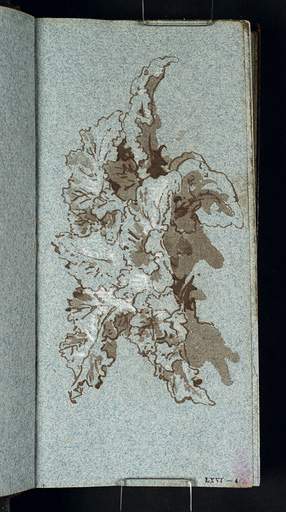The popular definition of a weed is “a plant in the wrong place”, which makes almost everything eligible, from an oak in a conifer woodlot to an orchid on the tennis court. For three or four centuries landscape painters agreed, and exiled lowly vegetation to the margins – usually, quite literally, to the lower foreground margin. Meandering through collections of early landscapes, you notice an undifferentiated frieze of wildings somewhere at the bottom of your field of vision – much where they would be on a real walk. They’re small, creeping, insignificant, wild nature as cosmetic afterthought. Most do not even have any real botanical identity, and have the stylised look of medieval posies.
That is until Dutch artists discovered burdock. The unmistakably expansive, foppish leaves of this familiar wayside weed began to appear in the foreground of paintings by Jan Wynants and Jacob van Ruisdael in the mid-seventeenth century. They soon spread to Claude Lorrain’s canvases, relieving dark corners or echoing the body curves of picnickers and dancers. By the early eighteenth century burdocks were invading English landscapes. Tufts sprout around the edges of pictures by Gainsborough, Stubbs, Joseph Wright and John Linnell.

Joseph Mallord William Turner
Study of the Leaves of a Burdock 1799–1800
Watercolour on paper sketchbook
© Michael Landy. Photo: Tate Photography
Just why this rather gawky plant should have been so privileged (it has no symbolic role in legend or folklore) is not easy to see, but J.M.W. Turner’s Study of the Leaves of Burdock c.1799–1800 does suggest one reason. The charcoal sketch highlights the sculptural quality of the leaves. They’re luxuriant, wavy edged, almost rococo, the opposite of the classically symmetrical acanthus. Their felted grey surfaces suggest leaves posing as free-carved stone. Ruskin, as outrageously human-centred as usual, was quite clear about their function in Creation, and therefore in painting: “The principal business of that plant being clearly to grow leaves wherewith to adorn foregrounds.” He sees burdock – in a wonderfully imaginative act of attention – as an exemplar of the beauty of irregularity: “When the extending space of a leaf is to be enriched with the fullness of folds, and become beautiful in wrinkles, this may be done either by pure undulation as of a liquid current along the leaf edge, or by sharp ‘drawing’ – or ‘gathering’ I believe ladies would call it – and stitching of the edges together.”
“Beautiful in wrinkles”: burdock could be seen as the Trojan horse through which the elegance of the ordinary entered landscape painting. The Pre-Raphaelites took up weeds with a relish. They were worthy of respectful painting just by being part of nature. But, possessed of a kind of humbleness too, they were also a rich source of moral symbols. William Holman Hunt’s Our English Coasts 1852, with its strayed sheep perched on the edge of a cliff, has been subject to all manner of pious religious and political interpretations. What is clear is that the foreground sheep, up to their ears in that riotous, entangling and thoroughly English weed bramble, are the ones that are not going to fall off.
John Raven’s Saintfoin in Bloom 1857 is almost, so to speak, post-Pre- Raphaelite in its pervading pink tone. But the sainfoin itself, a cultivated fodder species, is upstaged by the weeds in the foreground. The rough-bunched but exactly drawn poppies, mayweed and scabious (which are being “harvested” by the children in the background) aren’t just an ornamental frill, as weeds are in Claude, but a contrast and a challenge to the monotony of the crop plant. Again Ruskin seems to be at the artist’s shoulder. In Modern Painters he insiststhat painters “must be careful that [it]is nature to whom they go, nature in herliberty, not as servant of all work in thehand of the agriculturalist, nor stiffenedinto court dress by the landscape gardener.It must be the pure wild volition and energy of creation which they follow”.

Eliot Hodgkin
Undergrowth 1941
Tempera on canvas
41.3 x 36.8 cm
© Michael Landy. Photo: Tate Photography
When we break through into the twentieth century, the era of ecocide as well as genocide, weeds move centre stage as emblems of wild, regenerative energy, healers of vandalised earth. Eliot Hodgkin, while serving as an air raid warden during the Blitz, stalked the waste-ground of south London at the same time as Rose Macaulay was revelling in the weed jungles of the City bomb sites for her novel The World My Wilderness. Hodgkin’s Undergrowth 1941, with its forest of hogweed and dock, and a single bindweed flower glowing like a moonlit orchid, is the most exultant celebration of weeds since Dürer’s Large Piece of Turf 1503 four centuries earlier.
Now east London contemporary artists are putting up blue plaques by particularly resplendent patches of street weeds (Tagworts), and Michael Landy, best known for making an artwork out of the destruction of all his material possessions, none the less sees the “marvellous optimism” of urban weeds worthy of a series of meticulous and durable etchings.
Ralph Waldo Emerson generously suggested that a weed is not so much a plant in the wrong place as “a plant whose virtues have not yet been discovered”. Perhaps, in the desolation we are making of the planet, the weed’s moment has arrived.
